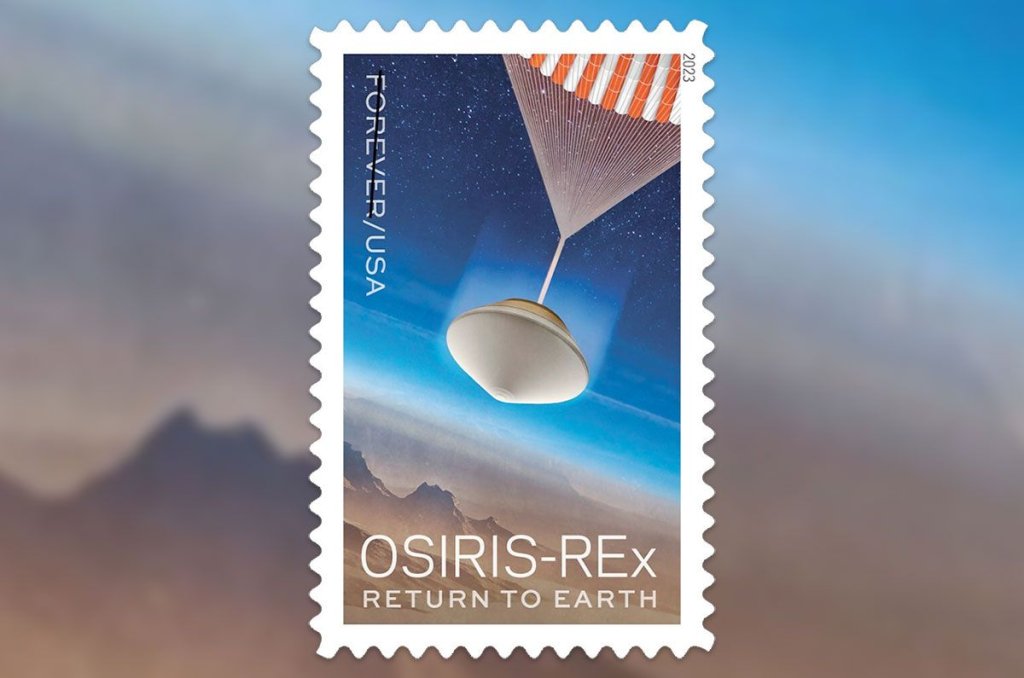The United States Postal Service (USPS) dropped news of a surprise space stamp on Tuesday (March 14), revealing it plans to mark the upcoming plunge of a capsule carrying the largest sample ever collected from an asteroid.
The “OSIRIS-REx Return To Earth” postage stamp (opens in new tab), to be issued later this year on a date still to be announced, honors NASA’s first mission to bring back asteroid samples for study. The stamp depicts the robotic probe’s sample return capsule descending under a parachute over the Utah desert, where the rock and dust-filled container is scheduled to land on Sept. 24, 2023.
“With this new stamp, the U.S. Postal Service celebrates NASA’s seven-year OSIRIS-REx mission to study and map the asteroid Bennu and deliver a sample of the surface to Earth in September 2023. The sample will help scientists learn how the solar system formed,” the USPS stated in a press release (opens in new tab).
Related: OSIRIS-REx asteroid samples will land on Earth in 2023 and scientists can’t wait
OSIRIS-REx is an acronym, which stands for: Origins, Spectral Interpretation, Resource Identification and Security Regolith Explorer. The name describes the mission’s goals. “Origins” refers to the study of the pristine carbon-rich material the spacecraft collected. “Spectral Interpretation” means measuring the composition of the asteroid. “Resource Identification” is assessing potential fuel, oxygen, water and minerals on the asteroid and “Security” relates to scientists’ calculating the odds that Bennu might collide with Earth.
The final part of the mission’s name, REx, is short for “Regolith Explorer,” referring to the study of the layer of loose material on the asteroid’s surface.
Launched from Cape Canaveral (opens in new tab) on Sept. 8, 2016, the van-sized OSIRIS-REx spacecraft orbited the sun for a year until it passed by Earth again. At that point, it used the planet’s gravity to help propel it toward Bennu, which orbits the sun but at a different angle than Earth.
OSIRIS-REx entered orbit around the 1,610-foot-wide (490 meters) asteroid in December 2018 and began photographing and mapping its surface to determine the best site from which to collect samples. Scientists were surprised to learn, from the images that the spacecraft sent back, that the asteroid’s surface was much different from what they had expected. Instead of being relatively smooth, it was rocky and cratered, so finding a sample collection site posed a challenge. Ultimately, a site located in a crater about the size of a tennis court was chosen.
The OSIRIS-REx spacecraft did not actually land on Bennu, but instead slowly descended toward its surface and extended a robotic arm (opens in new tab). A collection device at the hand-end of the arm released a puff of nitrogen gas that sent up a cloud of dust and rocks from the rocky body’s surface. More than two ounces of these materials were captured in a special container (opens in new tab) in the collection device, which then closed and retracted into the spacecraft.
Even though just a few ounces might seem like a small amount, it is the largest sample ever collected from an asteroid and the first asteroid sample collected by the United States. Japan previously returned asteroid material on its Hayabusa and Hayabusa2 (opens in new tab) missions.
OSIRIS-REx began its flight back to Earth on May 10, 2021. When it nears the planet this fall, the sample return capsule will separate from the larger spacecraft to plunge to the surface. The container and return method are similar to what was used by NASA’s Stardust mission to land material from a comet in 2006.
“OSIRIS-REx — a collaboration between NASA, the University of Arizona and Lockheed Martin — exemplifies American ingenuity, perseverance and teamwork,” the USPS said.
The “OSIRIS-REx Return to Earth” postage stamp will be issued in a pane of 20 Forever stamps. Forever stamps remain equal in value to the current First-Class Mail 1 ounce price.
Follow collectSPACE.com (opens in new tab) on Facebook (opens in new tab) and on Twitter at @collectSPACE (opens in new tab). Copyright 2023 collectSPACE.com. All rights reserved.

